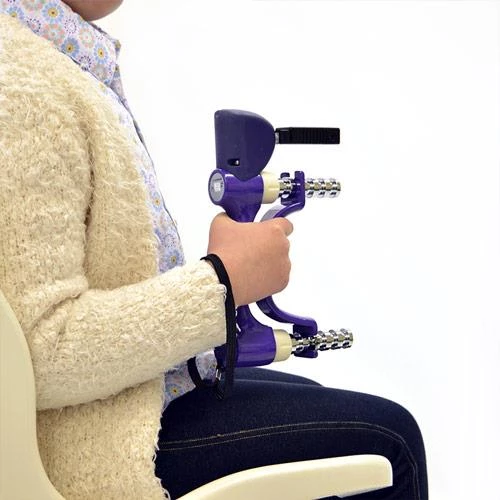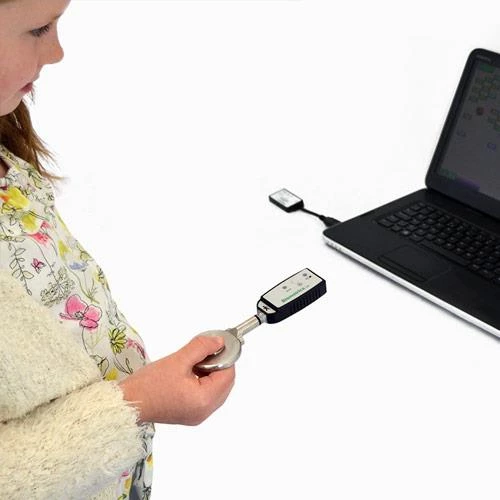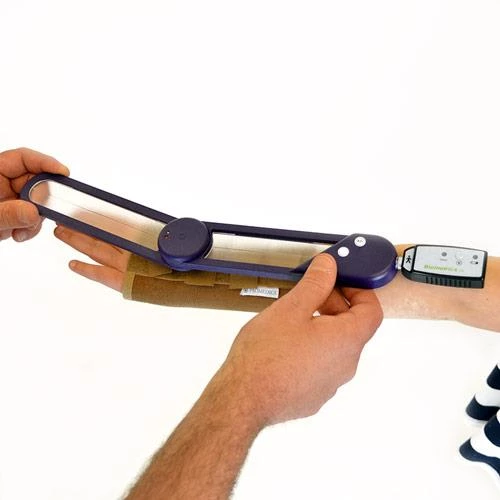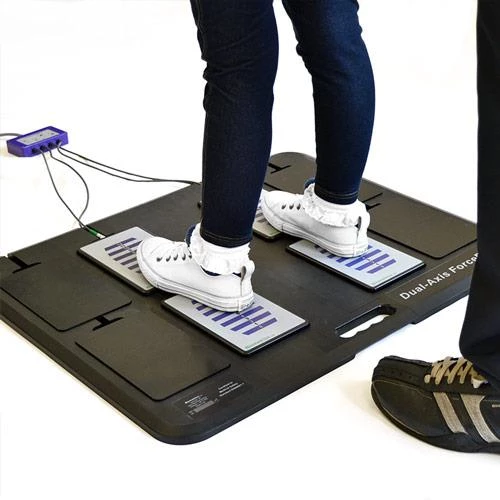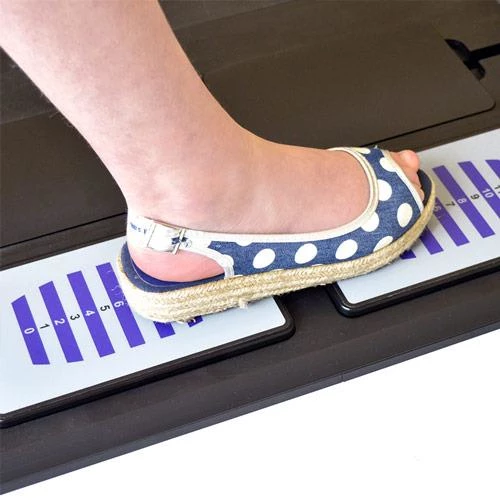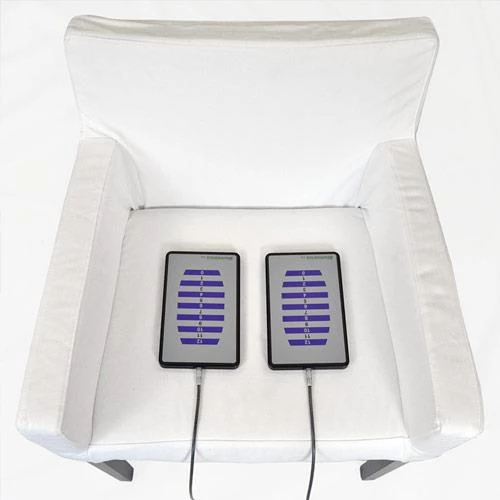Precise Evaluation
Rehabilitation goals for children vary according to the developmental phases they experience and clinicians need reliable methods of assessment to monitor change.
E-LINK Dynamometer
The E-LINK Dynamometer registers as little as 0.1kg/lb strength measurements through to a maximum of 90kg (200lbs). This encompasses those with chronic debilitating conditions, such as juvenile arthritis, as well as those with acute hand injuries.
The following tests, using the Dynamometer with E-LINK software, can be carried out quickly and accurately and include assessments that cannot be undertaken with a manual device:
Standard Peak Force Grip Test (1/4)
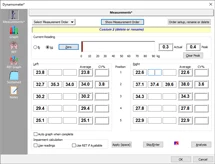
Three measurements can be quickly entered for each hand position as required. The software automatically calculates the average grip and the coefficient of variation percentage as an indication of the measurement consistency. A force distribution graph is displayed for the five positions.
Sustained Grip Test (2/4)
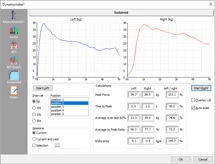
This test measures force over time for a 5, 10, 15 or 30 sec interval. Peak force, time to reach peak force, average to peak ratio percentage (sustainability) and fatigue rate are automatically calculated and immediately displayed. The current graph can be compared with a prior test to analyze progress.
Rapid Exchange Grip Test (3/4)
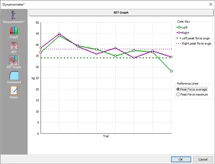
Undertaken for the detection of sub-maximal effort, this test is easily performed and documents the grip force applied for eight tests of each hand with a 1, 1.5 or 2 sec interval set timing. The results are displayed in both graph and table form for immediate analysis.
Progress Reports (4/4)
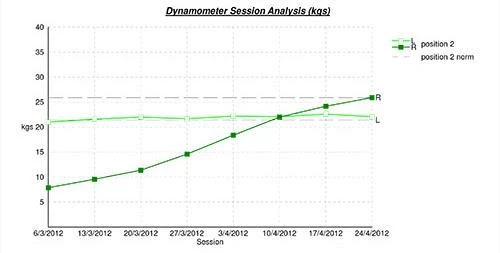
Progress Reports can be readily generated covering a maximum of 10 tests and the data is displayed in both graph and table format. Automatic calculations show the percentage of change from one session to another, the percentage of change from the first test and the percentage comparison to standard, normative Jamar data for both pediatric and adult values. Ideal as an Outcome Measure and for a Discharge Summary.
E-LINK Pinchmeter
The Pinchmeter easily and accurately measures a child's pinch strength from 0.1kg/lb measurement through to a maximum of 22kg (50lbs).
It has a unique, low profile design that permits measurement to be undertaken at a point closer to the end range than any other Pinchmeter device, either manual or electronic.
The software quickly and easily records the following:
Standard Peak Force Pinch Test (1/3)
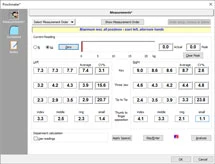
This test can be taken for the key (lateral), three jaw (tri-pod) and tip to tip positions. Three trials per position can be recorded and the software automatically calculates the average Pinch measurement and the co-efficient of variation percentage as an indication of the measurement consistency. Single measurements of Thumb to Digit Opposition can also be entered for each digit.
Sustained Pinch Test (2/3)
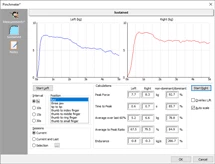
This test measures force over time for a 5, 10, 15 or 30 sec interval. Peak force, time to reach peak force, average to peak ratio percentage (sustainability) and fatigue rate are automatically calculated and immediately displayed. The current graph can be compared with a prior test to analyze progress.
Progress Reports (3/3)
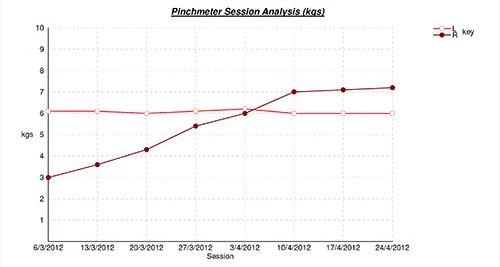
Progress Reports can be easily generated covering a maximum of 10 tests and the data is displayed in both graph and table format. Automatic calculations show the percentage of change from one session to another and the percentage of change from the first test. These Reports are ideal as an immediate clinical Outcome Measure and for Discharge Summaries.
E-LINK Goniometers, small and large
E-LINK Goniometers are precise electronic devices, designed for speed and accuracy of data collection. They are invaluable for busy clinic situations and for individual children in need of a speedy assessment to minimize discomfort from pain associated with lengthy evaluations.
The goniometer is simply placed over a joint and at the single click of a button the data is recorded in 1 degree increments and entered automatically into the software. This data is clearly displayed on the appropriate screen Graphic.
Progress Reports can be easily generated by the Software covering a maximum of 10 tests and displayed in both graph and table format.
- The small Goniometer is used for the hand to measure ROM for fingers and thumb
- The large Goniometer is used for the wrist, forearm, elbow, shoulder, hip, knee and ankle
- Amputation, ankylosis and arthrodesis can also be documented for the above joints
- The Software can also be configured to accommodate the Neutral Zero method of measurement
- E-LINK Goniometers – ideal for speedy and accurate ROM evaluation
E-LINK ForcePlates
Assessment of weight bearing stability and balance can be a major challenge for clinicians, particularly in busy clinical situations. The E-LINK Dual Axis ForcePlate System provides the solution by scientifically quantifying the symmetrical weight distribution of the child or young adult in both anterior-posterior (front/back) and medial-lateral (left/right) axes simultaneously. It accurately and objectively assesses the child's ability to maintain postural stability on a static surface and evaluates progress over time as an outcome measure.
- The Dual Axis ForcePlate System consists of four ForcePlates used with the BaseFrame to standardize position
- Position of the ForcePlates may be varied within the BaseFrame to accommodate different stance widths for young children through to teenagers
- The child is asked to stand on the ForcePlates with the medial arch placed over the gap between the front and back ForcePlates. Thus, foot positioning is standardized reducing any variability for analysis
- The standing balance assessment (in a 5,10,15,30 or 60 second test) measures fluctuations in the weight distributed over the ForcePlates. Results are displayed both graphically and in a text format for immediate feedback and analysis. The 'average % deviation' from the center documents the symmetry of stance while the 'standard deviation %' documents stability
- Up to 10 tests can be compared simultaneously for progress reporting over time and may be used as an outcome measure
- As an alternative, two ForcePlates can be used with the BaseFrame for evaluation of medial-lateral (left/right) balance or for unilateral anterior-posterior (front/ back) balance where there is need to differentiate weight-bearing between the child's heel and toes
- When removed from the BaseFrame the ForcePlates can be used for seated balance assessment and exercise or for bilateral Upper Limb exercise and training
- E-LINK ForcePlates are an ideal, flexible system for treating children with weight-bearing balance problems


